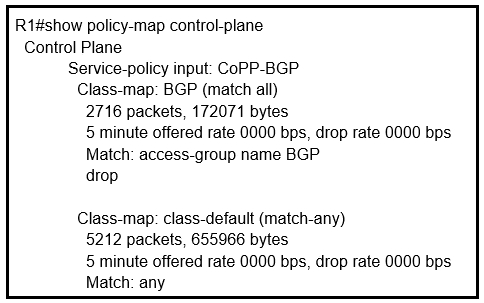Refer to the exhibit. What is the result of applying this configuration?

Refer to the exhibit. What is the result of applying this configuration?

The configuration shown indicates that the service policy 'CoPP-BGP' is applied to the control plane. Within this policy, the class-map 'BGP' matches an access group named 'BGP' and has a rule to 'drop' the matched traffic. This means any traffic that matches the 'BGP' access-list is being dropped. Therefore, the router cannot form BGP neighborships with any device that is matched by the access list named 'BGP', as the necessary BGP packets for establishing neighborships would be discarded.
Labbed with 3 routers the peers i set with ACL in class map could no establish session so C is correct.
C is correct
C seems the most logical considered some packets have matched and some other not
The correct answer is C
The given answer is correct then A. The question refers about the control-plane protection mechanism.. The configuration shows that the router is still gonna etablish the BGP relationship to a given number of peers, but not all( because of policy assigned to that class-map based on rate-limit condition)
I dont see how it can be any answer other than C. A tcp connection is required for BGP adjacencies to form. When the responding router matching the BGP acl sends its response packet its going to get dropped...
with this (below) ACL both incoming (179) and outgoing (179) are blocked. BGP cannot be established. R7#show ip access-lists Extended IP access list ACL_BGP 10 permit tcp any any eq bgp (45 matches) 20 permit tcp any eq bgp any (3 matches) R7#sh policy-map control-plane Control Plane Service-policy input: CoPP_IN Class-map: CL_BGP (match-all) 76 packets, 4826 bytes 5 minute offered rate 0000 bps, drop rate 0000 bps Match: access-group name ACL_BGP drop Class-map: class-default (match-any) 237 packets, 55172 bytes 5 minute offered rate 0000 bps, drop rate 0000 bps Match: any R7#
The correct answer is C
The correct answer is: C
The correct answer is: C
Its C, whoever admins this site is a nuffie.
C - labbed and existing neighbours that matched the ACL go down.
Not sure if the answer is A or C. One class-map states drop any thing name BGP, and another Class map states allow any.
Default class is always present. The class-map for cop says "drop". So matches for this access-list will be dropped.
it´s C
The A is correct because default class map has number Id 0 and other class map configured will take high number id 1or2
Ok so if the router can form BGP neighbourships with any other device, what are the marked packets 2716 ? These are dropped packets no ?
The correct answer is C